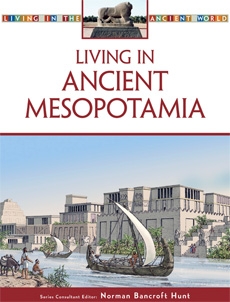| INTRODUCTION
What Mesopotamia Did for Us
Mesopotamia’s place in history is unique. It was here that, in the Western world, primitive humans became the first farmers, the first town dwellers, and the creators of urban civilization. In Mesopotamia were discovered the secrets of fire, of bronze, and of the wheel.
Literature began with the development of a universal writing system. Science began its first halting steps with simple and then ever more sophisticated mathematics. It was in Mesopotamia that kings evolved a code of common law on which much of history would depend. No wonder, then, that Mesopotamia is called the “Cradle of Civilization.”
Landscape and Climate
Mesopotamia means “between the rivers,” and is the name given to the narrow strip of land between the Tigris and Euphrates rivers. Mesopotamia forms the larger part of what historians call the “Fertile Crescent.”
The Fertile Crescent is a semicircle of land stretching from the southeast coast of the Mediterranean Sea, around the Syrian Desert north of Arabia, to the Persian Gulf.
The ancient region of Mesopotamia covered what today is the north of Syria, the southeast of Turkey, most of central Iraq, and a small part of western Iran. The northern areas are dominated by steep hills through which the Euphrates and Tigris flow in deep channels. The southern region is a mix of marshy plain and desert.
Throughout Mesopotamia, the typical climate consists of hot summers and relatively cold winters. Rainfall occurs in the winter and spring, but it is unevenly distributed and concentrated mostly on the northern rim. For this reason, only Upper Mesopotamia—the northern region—can support crops fed by rainfall. In the remainder, farming is dependent on the flood plains of the Euphrates, Tigris, and their tributaries. The ancient farmers also used irrigation canals running between the rivers. Only nomadic tribesmen lived in the northern central plain between the two rivers and beyond the rivers’ valleys.
A changing coastline Although the climate has remained relatively unchanged over 10,000 years, the course of the rivers in the southern plain has altered many times. Since the ancients relied on having a supply of water nearby, any towns along its banks had to be abandoned whenever the river changed its course. The two rivers carry a great deal of silt from the Turkish and Armenian Mountains, and over the years this has built up in the Persian Gulf. As a result the Gulf’s coastline has changed greatly from ancient times and today this has left ports such as Ur more than 150 miles inland.
The first farmers migrated from the Zagros Mountains by 6000 BCE, where they had learned to cultivate the wild wheat that grew in the rainy hills. They began to dig trenches to irrigate the plain, and began making settlements. They were the Sumerians, and this is when our story begins, on page 14.
1. Khorramshahr
2. Abadan
3. Khosrowabad
4. Al Faw
5. Mah Shahr
6. River Karun
7. Shatt al Arab (combined flow of Euphrates and Tigris)
8. Bubiyan (island belongs to Kuwait) | 